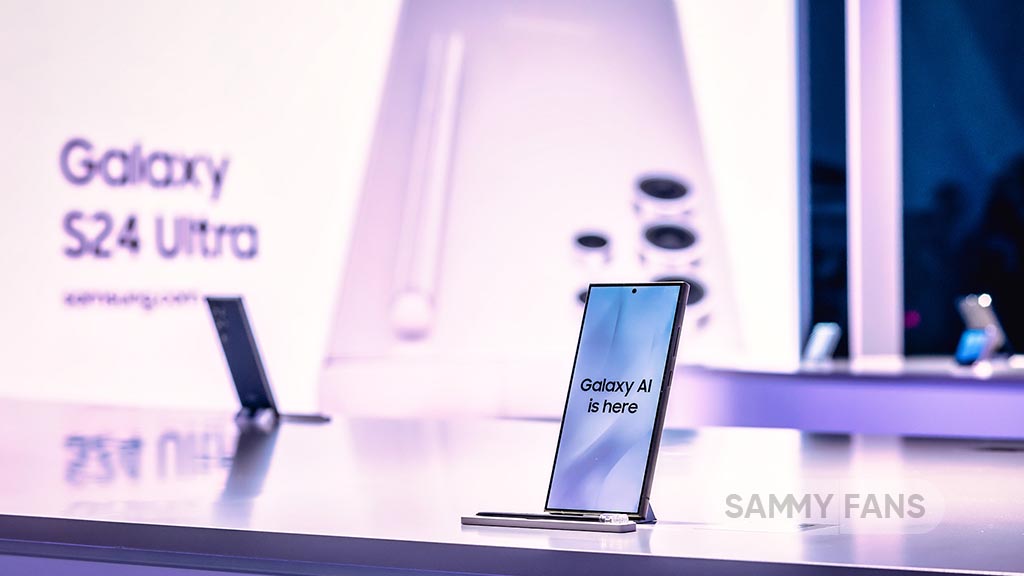Samsung
Samsung’s first gaming laptop with OLED display

Samsung Display is the world’s largest producer of digital communication displays. The company at the display week 2022 said that it is going to spotlight a wide range of most advanced display technologies.
Samsung Display is soon going to launch a gaming laptop that will feature an OLED screen with a 240Hz refresh rate, at the end of the year 2022. Samsung has already showcased the 15-inch Razer Laptop with OLED panel and QHD resolution at the display week.
DOWNLOAD SAMMY FANS APP
All the specifications of the laptop are not known but could feature an Intel’s 12th Generation CPU along with Nvidia RTX 3070 Ti GPU. Samsung showcased the new category of Gaming Foldable OLED that maximizes the portability when not in use. Holding the device vertically allows a multiple display setup, providing a rich gaming experience.

Samsung QD-Display is the world’s first self-illuminating display that has built-in quantum dots that does not need any backlight. The company has demonstrated the QD panels in three different sizes. 55-inch and 65-inch for TVs and 34-inch for monitors.
The upcoming display to feature HDR10+ and Dolby vision capabilities. OLED provides a faster pixel response and is suitable for a smoother gaming experience. Samsung has also redefined mobile displays at display week and showcased the concept prototypes including Flex G and Flex S.
The basic difference between Flex G and Flex S is that one folds inward twice and the other folds inwards as well as outwards. The Display Week will run for 3 days from May 10 to 13, 2022 in San Jose, California. You can visit there and have a look at flex gaming.
Get notified –
Aside from SammyFans’ official Twitter and Facebook page, you can also join our Telegram channel, follow us on Instagram and subscribe to our YouTube channel to get notified of every latest development in Samsung and One UI ecosystem. Also, you can follow us on Google News for regular updates.
Samsung
Samsung upscales 4G TDD on Galaxy S23 FE, A34, and A35 in Europe

Samsung has rolled out the updated 4G TDD band support firmware for Galaxy S23 FE, Galaxy A35, and Galaxy A34 smartphones in Europe. The fresh update enhances the 4G TDD band support to better network connectively.
According to the changelog, the new firmware for Samsung Galaxy S23 FE, Galaxy A35, and Galaxy A34 smartphones in Europe updates the Regional 4G TDD band support to deliver better network performance across various European countries.
It is important to note that Galaxy models purchased in Germany cannot receive signals in LTE TDD bands in several countries, including Belgium, Denmark, France, Luxemburg, Netherlands, Austria, Poland, Switzerland, and the Czech Republic.
Moreover, the update also improves the security and stability of the device. It also fixes some issues for error-free services.
Latest Firmware
- Galaxy S23 FE – S711BXXU2CXD3
- Galaxy A35 – A356BXXU1AXBB
- Galaxy A34 – A346BXXU6BXD2
If you have received the notification of the update then install it now to get a bug-free experience. You can also check the update by visiting the Settings app on your smartphone and opening the Software Update section. Now, click on the Download and Install option.
New Samsung Galaxy S23 firmware updates LTE TDD band support in Europe
Stay up-to-date on Samsung Galaxy, One UI & Tech Stuffs by following Sammy Fans on X/Twitter. You can also discover the latest news, polls, reviews, and new features for Samsung & Google Apps, Galaxy Phones, and the One UI/Android operating system.
Do you like this post? Kindly, let us know on X/Twitter: we love hearing your feedback! If you prefer using other social platforms besides X, follow/join us on Google News, Facebook, and Telegram.
Apps
Samsung updates Intelligence Voice Services for better performance

Samsung has pushed a new update for its Intelligence Voice Services app to version 1.1.12.38, which focuses on enhancing the overall performance and stability of the app. This latest update improves the app’s functionality and resolves existing issues for a more reliable experience.
The fresh update for the Samsung Intelligence Voice Services app does not include new features or changes but enhances the app’s capabilities. It fixes issues that users were facing in the previous version.
Samsung Intelligence Voice Service is essential for simplifying communication between Samsung’s native applications and the Galaxy Advanced Intelligence services. It sends data and specific prompts to the Language Learning Model (LLM) server, which processes the information and returns the results to the native applications.
The update enhances this service by focusing on performance and stability. The update is available for users via the Galaxy Store. If your device is eligible then you can install the update through the Galaxy Store app >> Menu option >> Updates. Also, you can download the update directly from the third-party app source link mentioned here.

Stay up-to-date on Samsung Galaxy, One UI & Tech Stuffs by following Sammy Fans on X/Twitter. You can also discover the latest news, polls, reviews, and new features for Samsung & Google Apps, Galaxy Phones, and the One UI/Android operating system.
Do you like this post? Kindly, let us know on X/Twitter: we love hearing your feedback! If you prefer using other social platforms besides X, follow/join us on Google News, Facebook, and Telegram.
Samsung
Exynos Samsung Galaxy S21 FE models grab April 2024 update in India

After Snapdragon models, Samsung has released an April 2024 security update for Exynos models of the Galaxy S21 FE smartphone in India. Users can identify the latest update through One UI build version G990EXXS8FXD1.
The fresh update improves system security and stability to enhance the overall performance. It protects against security threats by incorporating the latest security patches for Android. Also, it improves some functions to provide a better user experience.
Users of the Exynos Galaxy S21 FE smartphone in India will have to download a 248.39MB package to install the April 2024 security update. The update is based on One UI 6.0 and the company will soon release One UI 6.1 update for this smartphone.
To install the update, users should navigate to the Software Update section found within the device’s Settings. They can select ‘Download and install’ from there to initiate the update process.
Samsung Galaxy S21 FE Exynos April 2024 update – India #Samsung #OneUI #GalaxyS21FE pic.twitter.com/3QCwnuoJ5J
— Samsung Software Updates (@SamsungSWUpdate) April 25, 2024
Stay up-to-date on Samsung Galaxy, One UI & Tech Stuffs by following Sammy Fans on X/Twitter. You can also discover the latest news, polls, reviews, and new features for Samsung & Google Apps, Galaxy Phones, and the One UI/Android operating system.
Do you like this post? Kindly, let us know on X/Twitter: we love hearing your feedback! If you prefer using other social platforms besides X, follow/join us on Google News, Facebook, and Telegram.












